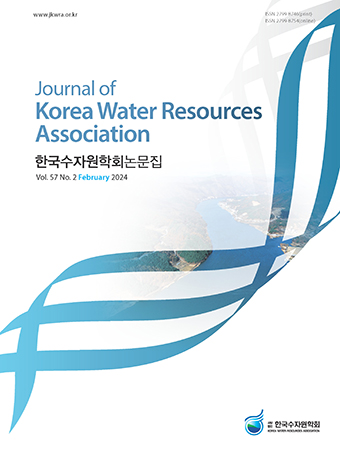Abstract
References
Baran, E., and Myschowoda, C. (2009). “Dams and fisheries in the Mekong basin.” Aquatic Ecosystem Health & Management, Vol. 12, No. 3, pp. 227-234. Environmental Protection Agency (2017). An overview of rainfall- runoff model types. EPA Report, EPA/600/R-14/152, p. 30. Hitogoto, M., Sakuraba, M., and Sei, Y. (2016) “Development of the real-time river stage prediction method using deep learning.” Annual Journal of Hydraulic Engineering (B1), JSCE, Vol. 72, No. 4, pp. 187-192. Hochreiter, S., and Schmidhuber, J. (1997). “Long short-term memory.” Neural Computation, Vol. 9, No. 8, pp. 1735-1780. Johnston, R. M., and Kummu, M. (2012). “Water resource models in the Mekong basin: a review.” Water Resources Management, Vol. 26, pp. 429-455. Jung, S. H., Lee, D. E., and Lee, K. S. (2018), “Prediction of river water level using deep-learning open library.” Journal of the Korean Society of Hazard Mitigation, Vol. 18, No. 1, pp. 1-11. Kim, S., and Tachikawa, Y. (2018), “Real-time river-stage prediction with artificial neural network based on only upstream obser-vation data.” Annual Journal of Hydraulic Engineering, JSCE, Vol. 62, pp. 1375-1380. Kokkonen, T. S., and Jakeman, A. J. (2001), “A comparison of metric and conceptual approaches in rainfall-runoff modeling and its implications.” Water Resources Research, Vol. 37, No. 9, pp. 2345-2352. Kummu, M., Tes, S., Yin, S., Adamson, P., Józsa, J., Koponen, J., Richey, J., and Sarkkula, J. (2014), “Water balance analysis for the Tonle Sap lake-floodplain system.” Hydrological Processes, Vol. 28, pp. 1722-1733. Lauri, H., Räsänen, T. A., and Kummu, M. (2014). “Using reanalysis and remotely sensed temperature and precipitation data for hydrological modeling in monsoon climate: Mekong river case study.” Journal of Hydrometeorology, Vol. 15, No. 4, pp. 1532-1545. Lee, D. E., Yu, W. S., and Lee G. H. (2018), “Large scale rainfall- runoff analysis using SWAT model: Case study: Mekong river basin”, Journal of the Korean Society of Agricultural Engineers, Vol. 60, No. 1, pp. 47-57. Lee, G. H. (2008). Assessment of prediction uncertainty due to various sources involved in rainfall-runoff modeling. Doctoral Thesis, Kyoto University, Japan. Minns, A. W., and Hall, M. J. (1996), “Artificial neural networks as rainfall-runoff models.” Hydrological Sciences Journal, Vol. 41, No. 3, pp. 399-417. Olah, C. (2015). “Understanding lstm networks.” GITHUB blog, http://colah.github.io/posts/2015-08-Understanding-LSTMs/. Raghavan, S. V., Vu, M. T., and Liong, S. Y. (2012). “Assessment of future stream flow over the Sesan catchment of the lower Mekong basin in Vietnam.” Hydrological Processes, Vol. 26, No. 24, pp. 3661-3668. Reungsang, P., Kanwar, R. S., and Srisuk, K. (2010). “Application of SWAT model in simulating stream flow for the Chi river Subbasin II in Northeast Thailand.” Trends Research in Science and Technology, Vol. 2, No. 1, pp. 23-28. Shreenivas, L., and Shrikant, C. (2010) “Comparison of data driven modelling techniques for river flow forecasting.” Hydrological Sciences Journal, Vol. 55, No. 7, pp. 1163-1174. Shrestha, B., Babel, M. S., Maskey, S., Griensven, A. V., Uhlenbrook, S., Green, A., and Akkharath, I. (2013). “Impact of climate change on sediment yield in the Mekong river basin: a case study of the Nam Ou basin, Lao PDR.” Hydrology and Earth System Sciences, Vol. 17, No. 1, pp. 1-20. Sok, K., and Oeurng, C. (2016). “Application of HEC-HMS model to assess streamflow and water resources availability in Stung Sangker Catchment of Mekong’ Tonle Sap lake basin in Cambodia.” Preprints, 2016, 28 December. Sun, W. C., Ishidaira, H., and Bastola, S. (2010). “Towards improving river discharge estimation in ungauged basins: calibration of rainfall-runoff models based on satellite observations of river flow width at basin outlet.” Hydrology and Earth System Sciences, Vol. 14, No. 10, pp. 2011-2022. Tran, Q. K., and Song, S. K. (2017). “Water level forecasting based on deep learning: a use case of rinity river-Texas-The United States.” Journal of KIISE, Vol. 44, No. 6, pp. 607-612. Vilaysane, B., Takara, K., Luo, P., Akkharath, I., and Duan, W. (2015). “Hydrological stream flow modelling for calibration and uncertainty analysis using SWAT model in the Xedone river basin, Lao PDR.” Procedia Environmental Sciences, Vol. 28, pp. 380-390.
Information
- Publisher :KOREA WATER RESOURECES ASSOCIATION
- Publisher(Ko) :한국수자원학회
- Journal Title :Journal of Korea Water Resources Association
- Journal Title(Ko) :한국수자원학회 논문집
- Volume : 51
- No :6
- Pages :503-514
- Received Date : 2018-02-12
- Revised Date : 2018-03-15
- Accepted Date : 2018-03-15
- DOI :https://doi.org/10.3741/JKWRA.2018.51.6.503




 Journal of Korea Water Resources Association
Journal of Korea Water Resources Association










